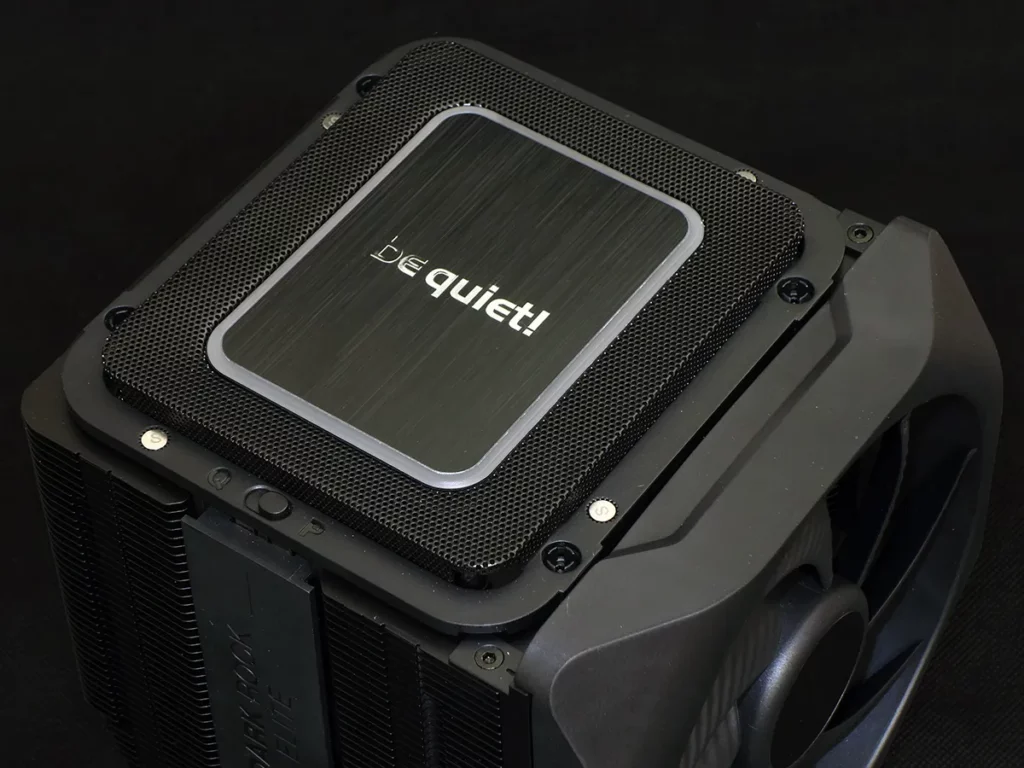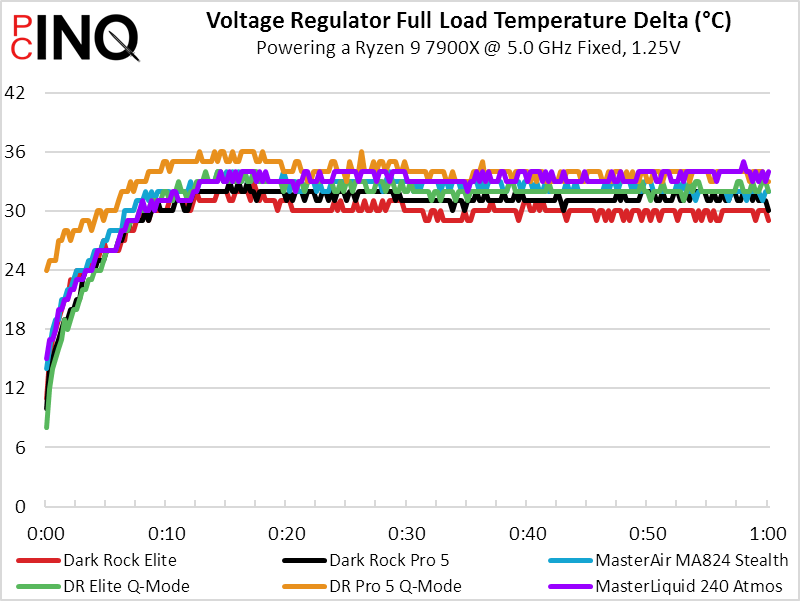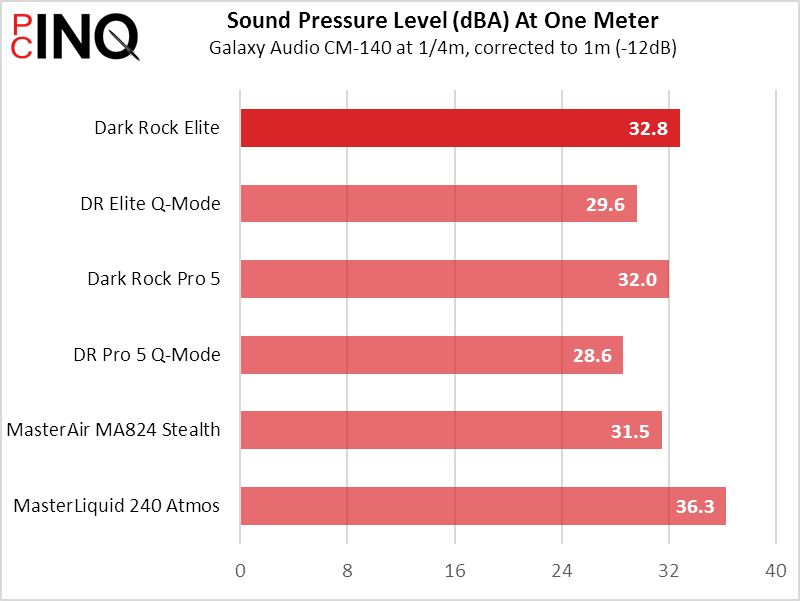be quiet! Dark Rock Elite CPU Cooler Review
It’s only been a few weeks since we reviewed the latest $100 (now $90) CPU cooler from be quiet!, but the brand best known for its quiet cases isn’t ready to cede any territory to competitors: Even though its Dark Rock 5 costs less and performs better than its closest competitor, the firm wants those who still want to spend that much money to know that it can make better use of those few extra bucks to go one better than even its class-winning Dark Rock 5. Enter the Dark Rock Elite.
| be quiet! Dark Rock Elite | |
| Type | Cross Draft Dual Tower |
| CPU Support | LGA 1700/1200/115x, AM5/4 |
| Height/Width/Depth | 168mm / 136mm / 146mm |
| Base Height | 41mm |
| Offsets | 26mm forward w/front fan |
| Fan Size | (2) 135mm x 25mm |
| Connectors | (1) PWM, (1) ARGB |
| Weight | 1432g (50.5oz) w/Intel kit |
| Web Price | $110 |
An MSRP difference of only $10 probably makes you expect that you’re only paying for the Elite cooler’s ARGB light ring, but the firm also upsized the front fan to 135mm using a custom frame that’s designed to maximize clearance. The rest of the kit is identical to the previously reviewed Dark Rock 5, with its Intel cross brackets and behind-motherboard supply plate, AMD cross brackets and spacers designed to fit the factory support plate included with AMD motherboards, the long-shaft #2 Phillips screwdriver, a tube of thermal paste, and all the hardware needed to connect these brackets to a motherboard.

The Dark Rock Elite’s top cover features a removable trim ring that conceals a speed switch that we recommend most users not use: Both fans feature PWM control, so that any properly configured motherboard can control fan RPM to keep the system quiet under anything less than the direst of thermal conditions. Sliding the switch to position Q simply limits how far the motherboard is allowed to go in its efforts to prevent CPU damage.

A look at the base shows just how difficult it is to tell the Dark Rock Elite’s heat sink from the Pro 5 version, as it has the same seven heat pipe layout and perfectly flat copper base that appears to have been lathe cut from square bar stock. The center fan still provides power from a motherboard PWM header through a special pass-through connector, though the addition of an ARGB cable for the top cover does stand out a little.

While the top trim ring uses magnets to stick to the top of the center fan bracket, the center fan bracket snaps onto four plastic pins atop the Dark Rock Elite’s heat sink. Notice that the bottom seven fins of the heat sink don’t extend all the way to the front fan: The Dark Rock Elite has 63mm with its 135mm front fan slid all the way up to the bottom of the first long cooling fin and 32mm of memory clearance with the fan slid down to the top trim ring. Builders should keep in mind when determining DIMM and even side panel clearance that the total height of this cooler will be DIMM height plus 135mm.

Since it uses the same hardware as the Dark Base Pro 5, we recycled the image from that unit’s installation. Long screws hold the AMD adapter brackets tight against plastic spacers, using the motherboard’s factory support as an anchor point.

The two spring screws that hold the base of the Dark Rock Elite heat sink to its motherboard brackets have #2 Phillips heads, which explains why its manufacturer includes a matching long-shaft screwdriver in its installation kit.

And finally, the payoff: The Dark Rock Elite’s ARGB ring can be set to any color and/or pattern that’s offered by the connected ARGB controller. Since the cooler doesn’t include a lighting controller, we connected it to our motherboard’s nearest ARGB header.

| System Configuration | |
| Case | Thermaltake Ceres 500 TG ARGB |
| CPU | AMD Ryzen 9 7900X: 12 cores/ 24 threads, 64MB L3 Cache O/C to 5.00 GHz at 1.25 V Core |
| Motherboard | ASRock B650E PG Riptide WiFi, BIOS 1.18 |
| RAM | Sabrent Rocket SB-DR5U-32GX2 64GB DDR5-4800 |
| System Drive | HP SSD FX900 M.2 1TB NVMe SSD |
Test Results
Thermal differences narrow over time as if some device within our system is acting as a giant heat pool, but the only part that we can think of that would have this effect is the glass side panel. The Dark Rock Elite beats all air-cooling configurations and comes within a couple degrees of Cooler Master’s most powerful 2x120mm closed loop in CPU temperature control.

We always remember to configure our CPU coolers to assist voltage regulator heat sink airflow…because most CPU voltage regulators don’t have their own fans and those that do tend to be far noisier. The Dark Rock Elite’s front fan is a bit larger that other air coolers, leaks more air under the bottom of the heat sink, and better cools voltage regulator sinks via its extra leaked air.

The Dark Rock Elite’s slightly larger front fan appears to give the cooler a slightly larger noise profile, but differences of a decibel or less are very difficult to appreciate. Full-speed noise levels amazingly reflect the cooling performance position of each sample.

The Dark Rock Elite was so much quieter than the liquid cooler that it easily topped cooling-to-noise ratio, despite its second-place cooling performance. Its full-speed mode also beat competing air coolers in cooling-to-noise, and its quiet mode even leads the Dark Rock Pro 5’s quiet mode. Having noted this, please remember that we do not recommend using “quiet mode” when using any of these coolers with a temperature-based fan controller such as a motherboard’s PWM header, as doing so limits the maximum cooling potential without reducing average noise.

With better cooling performance than even the previously awarded Dark Rock Pro 5, the Dark Rock Elite becomes our premiere air-cooling sample. With its ARGB accent ring, it might even win over a few more show system builders. That combination probably adds enough worth to offset its 10% price premium to equalize value, but it’s the performance superiority that earns the Dark Rock Elite our top award.
| be quiet! Dark Rock Elite (BK037) | |
| Pros: | Cons: |
| Ultimate air cooling performance Competitively low noise Small price premium over Pro 5 | Space = 135mm plus DIMM height Heavy to hang from flimsy motherboard |
| The Verdict: | |
| The Dark Rock Pro 5 outperforms its closest Big Air cooling rival while also being slightly smaller, lighter, better-built and cheaper. | |


